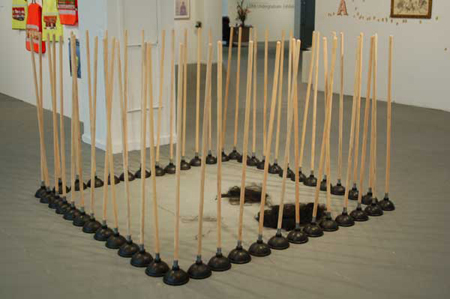
Warhol shows are too often loud, lack focus and are filled with work of varying quality. That’s what I was expecting when I recently visited Chicago’s Museum of Contemporary Art to see Andy Warhol/Supernova: Stars, Deaths, and Disasters, 1962–1964. What I found was something quite different: a show that is small, intimate and macabre.
Supernova doesn’t consume the first floor galleries at the MCA like one might expect, given all the ads around town. Instead, the show’s 27 paintings are nestled way up on the fourth floor in just four rooms.
I appreciate the restraint curator Douglas Fogle showed by exhibiting only works made between the years of 1962 and 1964. It’s nice to not be overwhelmed. I spent more time with each piece and I can recall more details, like the two blobs that made Elvis’s gun in “Elvis I & II” (1963) and the curved exaggeration of Marilyn’s lip in “Turquoise Marilyn” (1962). This thin slice of time and of Warhol’s oeuvre allows viewers to think about life during that time, as seen through the artist’s eyes.
Life in the early sixties, from Warhol’s perspective, seemed grim. The superstars of the show are paintings of two of the most conflicted celebrities ever, Elvis Presley and Marilyn Monroe. It’s hard to look at a young, sexy Elvis without thinking about how he died—fat and drugged out. It made me wonder if Andy, himself a conflicted soul, foresaw the tragic turn Elvis’s life would take. Marilyn’s beauty is similarly fragile when taking into account her mentally unstable mother and tumultuous relationships. These are just the beginnings of a fantastically depressing show.
In one room there are paintings of wanted fugitives, the electric chair in Sing-Sing prison, and works based on newspaper coverage of the civil rights protests in the early sixties. Around the corner, the viewer is confronted by images of car crashes from “The Disaster Series” (1963) and then by several versions of Jacquelyn Kennedy stricken with the grief of an entire country after her husband, President John F. Kennedy, was assassinated in November 1963. The show ends with an homage painted for two women who died after eating a bad can of tuna.
Have I mentioned how much I liked seeing the darker side of this man who I normally associate with glitter, bright colors, and cute little soup cans?
The show is also more about Andy, or I suppose, the person Warhol wanted us to believe he was. Valuable gallery wall space is given to a generous number of quotes from the artist; there are audio and video interviews with Warhol’s colleagues and acquaintances and, my favorite, a room full of his source material. Among the items is a photograph of Marilyn with the artist’s crop markings and a Life magazine addressed to “Mr. A. Warhol” with Jackie’s face cut from the cover of Kennedy’s funeral scene. Seeing that cover so close to Warhol’s painting was worth the admission fee alone.
The show also reiterates how important Warhol’s practice was in the history of art making. In an audio interview, gallerist Irving Blum from Ferus, the Los Angeles gallery that first showed Warhol’s “Elvis Series,” described trying to convince viewers that Andy’s screenprints were paintings. “They’re paintings because the artist says they’re paintings,” he said to a public that was reluctant to accept such a straightforward answer. Today, it’s easy to forget how revolutionary Warhol’s practice was. Not only did he open the art world to a whole slew of photomechanical processes, he also helped democratize portraiture by appropriating images of the rich and famous from fan sites and magazines instead of painting from the wealthy subject himself or herself. To Warhol, the celebrity and tragedy of public figures was the material from which America was made and, therefore, should be used as any other resource.
People either love Warhol or they hate him. This show won’t convert anyone but, for those of us who already adore him, the show is a glimpse into a side of his practice less explored.
Organized by the Walker Art Center, Minneapolis, Andy Warhol/Supernova runs through June 18 at the Museum of Contemporary Art before traveling to the Art Gallery of Ontario.







